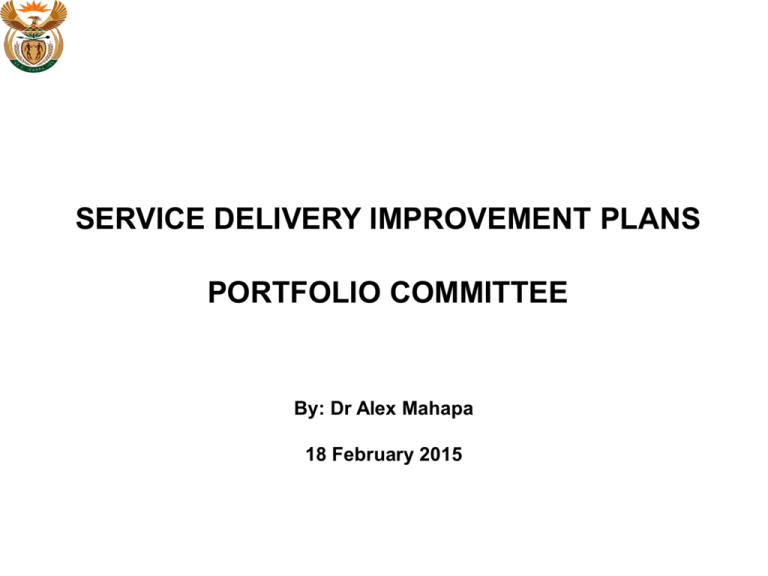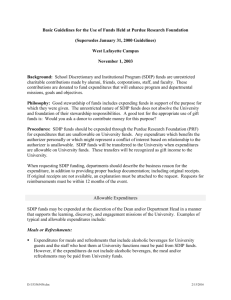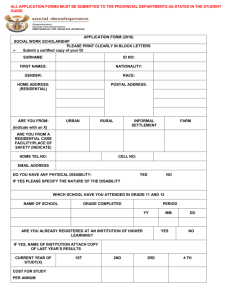SDIP PROGRESS REPORTING - Parliamentary Monitoring Group
advertisement

SERVICE DELIVERY IMPROVEMENT PLANS PORTFOLIO COMMITTEE By: Dr Alex Mahapa 18 February 2015 CONTENT Background & Context SDIP Status & Why Poor Performance Interventions • Wayforward. BACKGROUND Chapter 1, Part III, C.1 of the Public Service Regulations: An EA shall establish and sustain and SDIP for he/his department, indicating: services to be provided, consultation arrangements, mechanisms for promoting access, service standards mechanisms for providing information, mechanisms for complaints handling C.2 of the Regulations: An EA shall publish an annual statement of public service commitment which sets out the department’s service standards that citizens can expect and which indicates how the department will meet each of the standards BACKGROUND • The White Paper on the Transformation of Service Delivery (Batho Pele), 1997 states in paragraph 7.1.2 that HOD’s are responsible for SDIPs and that this responsibility should be clearly assigned to a person or group of people, accountable directly to the HOD. • Paragraph 7.1.5 describes that the relevant Minister/MEC/ executing authority must approve the department’s SDIP and that a copy of the approved document must be sent to the DPSA to inform it’s yearly progress report to Parliament. BACKGROUND A 2008 DPSA Directive on SDIPs meant to improve on “compliance and quality” requires: • Departments to submit SDIPs by 31/03/ of every 3 years and the annual reporting aligned with the MTEFs. • The SDIPs should be signed off by the Head of Department (HOD) and Executive Authority (EA). • There should be an indication of how SDIPs are cascaded to service points. CONTEXT OF SDIPS The SDIP are underpinned by the following: ◦ Value add for the institution through strategic focus to two or three priority services for continuous improvement, and specification of the actual and future service beneficiaries. ◦ The specification of consultation arrangements with the service recipients; means of access to services; barriers to access, and the strategies to remove these barriers. ◦ Specification of the existing and future service standards for the services to be delivered. ◦ The existing and future arrangements on how information about the department’s services are provided; and ◦ A system or mechanisms for managing complaints must be specified. OVERALL SDIP STATUS The update of the SDIP status and is around the following key deliverables: - Submission rate to ensure compliance with the legislative framework; - Emerging issues on the Quality of Submitted Plans; and - Annual progress reporting against the set targets to determine progress on continuous service delivery improvements and the ultimate impact. a) Generic Observations with the Submission rate: SDIPs submission picking up slowly as opposed to 100% in 1st quarter of the reporting cycle to allow quality implementation, monitoring, reporting and feedback especially to the beneficiaries. Example of how the SDIP submissions were made during the current cycle (2012/15): • 2012/13: 68%: 2013/14:85%; 2014/15: 88% (National & provincial departments). UPDATE ON 2012/2015 SDIP COMPLIANCE FIGURES DEPARTMENTS PROVINCES Grand total compliance: National & Provincial departments COMPLIANCE RATE PERCENTAGE 132/150 88% COMPLIANCE BREAKDOWN FOR NATIONAL & PROVINCES: Compliance in National departments Compliance in Provinces 28/42 67% Eastern Cape 13/13 100% Free State 10/11 91% Gauteng 12/12 100% KZN 13/14 93% Limpopo 11/11 100% Mpumalanga 12/12 100% Northern Cape 9/11 82% North West 9/11 82% Western Cape 13/13 100% 104/108 96.29% OBSERVATIONS:SDIP STATUS b) Quality of submitted SDIPs remain poor: almost 80% of the approved submitted SDIPs obtained below quality ratings at a scale of “0-5 rating. The following are some of the observations for the continued poor quality: • SDIPs signed by HODs & MECs for compliance sake. There seems to be no thorough thoughts applied on how the submissions would impact on service delivery. • Little evidence of a clear relationship between the department’s performance improvement plan and the content of the SDIPs. This includes the non alignment of the SDIPs to the strategic plans nor operational plans of departments. • Non-compliance by Departments affected by re-organisation. They found it difficult to develop SDIPs when still trying to understand their mandate and operations. OBSERVATIONS:SDIP STATUS Cont... • No clear understanding of the departmental strategic processes that should feed into the SDIP, including evidence that departments’ developed activities aimed at addressing the identified problematic areas will bring actual improvements; • The SDIP is supposed to be a departmental strategic tool to enhance efficiency and effectiveness in service delivery, however, its location and alignment thereof with the planning and budget cycle remains a serious challenge. • SDIPs developed by one person in some areas and is not an all-inclusive approach. This compromise ownership; buy-in and general implementation, monitoring and reporting on the SDIP progress made. OBSERVATIONS: SDIP PROGRESS REPORTING Overall submission of progress reports against the submitted SDIPs remains a challenge across the national and provincial departments. The progress reports received by the DPSA are as follows over the mentioned periods: PERIOD SUBMISSION TOTAL 2009/2012: 3 out of 118 (3.5%) national and provincial departments submitted progress reports 2012/2013 4 out of 71 (2.8%) national and provincial departments submissions received 2013/2014 22 out of 131 (29%) national and provincial departments submitted progress reports. OBSERVATIONS: SDIP PROGRESS REPORTING (Con...) Breakdown of 2013/14 submission: 22/131 (17%) SDIPs submitted; breakdown: YEAR NAME OF DEPARTMENT 2013/14 National Departments: 5/42 = 11.9% •DTI •NPA •STATSSA •DIRCO •SASR 2013/14 PROVINCIAL DEPARTMENTS: Northern Cape: 1/11 departments: 9% •Social Development Eastern Cape: 11/13: 84% •Roads and Public Works •Economic Development, Environmental Affairs and Tourism •Provincial Planning and Treasury •Human Settlements •Rural Development and Agrarian Reform •Social development and Special Program •Education TOPCulture SECRET •Sport, Recreation, Arts and STATUS OF SDIP PROGRESS REPORTS (Cont...) Breakdown of 2013/14 submission: 22/131 (17%) SDIPs submitted Cont... YEAR NAME OF DEPARTMENT 2013/14 Limpopo Provincial Departments: 5/11: 45% • • • • • Office of the Premier; Provincial Treasury; Public Works; Roads & Transport; and Agriculture. The challenges with the non-submission of progress reports is critical to monitoring and reporting on progress and can be attributed to: • Development of non-implementable and non-aligned SDIPs. Some SDIPs demonstrate little evidence of appropriate resource allocation especially if SDIPs are perceived not to be adding value to the department’ specific’s critical priority service delivery areas. • Absence or little top management support and buy-in towards SDIP implementation, monitoring, reporting and feedback to beneficiaries; and • Non alignment of SDIPs to the Operations Management value chain & tools. INTERVENTIONS Interventions and Institutionalising of SDIPs include support with advocacy on the development of SDIPs, improvement of quality to ensure response to the critical service delivery issues within the department; monitoring and feedback mechanisms using: • Ongoing workshops to departments and strengthening of sector coordination to ensure SDIP relevance as a strategic mechanism to ensure continuous improvement and quality delivery to all within the public service. • Continuous improvement and alignment with other service delivery tools/instruments in strengthening development; implementation; monitoring and reporting. • Targeted SDIP support provided to non-complaint provincial & national departments and those affected by macro reorganisation. Promote sharing of emerging good practices through the Service Delivery Improvement Forums and Frontline Service Delivery Improvement Programme:. INTERVENTIONS (Cont...) • Inside and Outside strategic thrust and support to the SDIP development, implementation, monitoring and reporting. • National SDIP Evaluation by DPME and DPSA to identify gaps and recommendations for continuous improvements. • Yearly implementation reports and reporting to the different stakeholders and reporting structures which include Cabinet. WAYFORWARD • Dedicated and focused 5 year SDIP support plan aligned to the departmental strategic plan developed and will be rolled out to institutionalise SDIPs across the public service. • Strengthened support through A step by step SDIP manual Operations Management Planning tools to ensure relevance, effectiveness and efficiency of the SDIPs across the public service. • Promoting the sharing and/or replication of emerging good practices through the Service Delivery Improvement Forum; and • Continued response to further capacity building needs provided through a series of workshops taking place since 2011 as directed by FOSAD’s Plan of Action.








